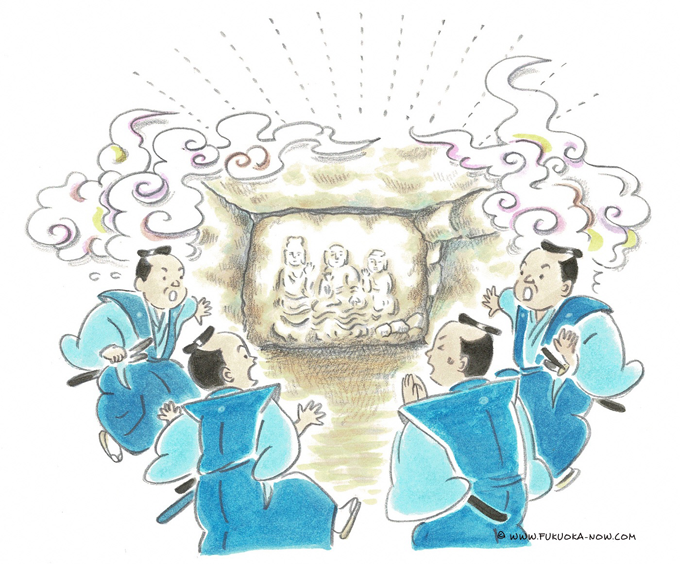Hakata Culture vol.154
Kosoji: Home of the Anakannon

In Minami Ward, Kosoji Temple is home to an old tomb called the Anakannon dating back to the late Kofun era (6th century). The tomb mound measures approximately 20 meters in diameter and features a multi-room chamber made from massive stones. The Amida Buddha is carved in relief on the back wall of the chamber with Kannon (Goddess of Mercy) on one side and the bodhisattva Mahasthamaprapta on the other. This is where the name Anakannon comes from. (In Japanese, ana means hole.)
According to one legend, when Nagamasa Kuroda was looking to use stones from this area to build Fukuoka Castle, Kannon appeared to him in a dream and warned him that her home was about to be destroyed. Upon closer inspection, he found the carving of Kannon on one of the stones and decided to build a temple on the site. The site was revered by successive feudal lords, and in 1693, Kosoji was erected inside the stone cavern.
Another interesting attraction is the graves of 47 ronin that were reproduced on the temple grounds. The 47 ronin were a group of leaderless samurai who sought revenge for the death of their lord and later committed ritual suicide in a historical event called the Ako vendetta. This incident is the basis of the famous puppet theater and kabuki play Chushingura. The actual graves are located at Sengakuji Temple in Tokyo, but in 1935, a local investor paid to have a reproduction made at Kosoji.
The temple now holds a festival every year on December 14, the date of the Ako vendetta, to commemorate the 47 ronin. You won’t want to miss the demonstration of the yoryu-kakae ozutsu, a hand-held cannon from the Edo era with ties to the Fukuoka Domain. Similar demonstrations are also held during the Fukuoka Castle Cherry Blossom Festival (Mar. ~ Apr.) and at the Hakozaki Shrine Satsuki Festival (May).
古墳に彫られた観音像・興宗寺(穴観音)
福岡市南区の興宗寺(こうそうじ)の境内には、通称「穴観音」と呼ばれる古墳があります。墳丘は推定直径が約20メートル、複数の部屋をもった横穴式石室で、古墳時代後期(6世紀)のものです。石室には巨大な岩が使われていて、奥の壁の中央には阿弥陀如来が、その左右には観音菩薩と勢至菩薩が浮き彫りにされています。ここから穴観音という名前が生まれました。
伝承のひとつによれば、黒田長政が福岡城を築城したとき、このあたりの岩屋の石を使おうとしたところ、夢の中に観音菩薩が現れて「私の住み家が壊されようとしている」と告げたそうです。よくよく調べてみると、石に観音像が刻まれているのが発見され、ここに拝殿を造ったとされます。その後も福岡藩の歴代藩主から大切にされ、1693年には岩屋の下に興宗寺が建立されました。
もうひとつ、ここにはめずらしいものがあります。赤穂浪士四十七士のお墓を再現したものです。18世紀初頭に実際にあった赤穂事件は、47人の侍が討ち入りして主君の敵をとり、その後に切腹しました。人形浄瑠璃や歌舞伎の演目として知られる「忠臣蔵」のもとになった事件です。本物の墓は東京・高輪の泉岳寺にありますが、ある人が私財を投じてそっくりそのまま再現しました。
赤穂浪士のお墓が再現されたのをきっかけに、討ち入りのあった毎年12月14日には福岡義士祭が行われるようになりました。見逃せないのが「陽流抱え大筒」の実演です。江戸時代から武術のひとつとして福岡藩に伝わるもので、大筒を手に抱えて撃つ迫力ある砲術です。福岡義士祭のほかには、福岡城さくらまつり(3~4月)、筥崎宮さつき大祭(5月)などでも披露されています。

